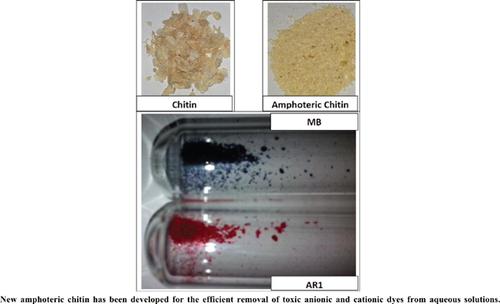Current Analytical Chemistry ( IF 1.7 ) Pub Date : 2021-08-31 , DOI: 10.2174/1573411016666200106104414 Reda M. El-Shishtawy 1 , Abdullah M. Asiri 1 , Nahed S. E. Ahmed 2

|
Background: Color effluents generated from the production industry of dyes and pigments and their use in different applications, such as textile, paper, leather tanning, and food industries, are high in color and contaminants that damage the aquatic life. It is estimated that about 105 of various commercial dyes and pigments amounted to 7×105 tons are produced annually worldwide. Ultimately, about 10-15% is wasted into the effluents of the textile industry. Chitin is abundant in nature, and it is a linear biopolymer containing acetamido and hydroxyl groups amenable to render it atmospheric by introducing amino and carboxyl groups, hence able to remove different classes of toxic organic dyes from colored effluents.
Methods: Chitin was chemically modified to render it amphoteric via the introduction of carboxyl and amino groups. The amphoteric chitin has fully been characterized by FTIR, TGA-DTG, elemental analysis, SEM, and point of zero charges. Adsorption optimization for both anionic and cationic dyes was made by batch adsorption method, and the conditions obtained were used for studying the kinetics and thermodynamics of adsorption.
Results: The results of dye removal proved that the adsorbent was proven effective in removing both anionic and cationic dyes (Acid Red 1 and methylene blue (MB)), at their respective optimum pHs (2 for acid and 8 for cationic dye). The equilibrium isotherm at room temperature fitted the Freundlich model for MB, and the maximum adsorption capacity was 98.2 mg/g using 50 mg/l of MB, whereas the equilibrium isotherm fitted the Freundlich and Langmuir model for AR1 and the maximum adsorption capacity was 128.2 mg/g. Kinetic results indicate that the adsorption is a two-step diffusion process for both dyes as indicated by the values of the initial adsorption factor (Ri) and follows the pseudo-second-order kinetics. Also, thermodynamic calculations suggest that the adsorption of AR1 on the amphoteric chitin is an endothermic process from 294 to 303 K. The result indicated that the mechanism of adsorption is chemisorption via an ion-exchange process. Also, recycling of the adsorbent was easy, and its reuse for dye removal was effective.
Conclusion: New amphoteric chitin has successfully been synthesized and characterized. This resin material, which contains amino and carboxyl groups, is novel as such chemical modification of chitin hasn’t been reported. The amphoteric chitin has proven effective in decolorizing aqueous solution from anionic and cationic dyes. The adsorption behavior of amphoteric chitin is believed to follow chemical adsorption with an ion-exchange process. The recycling process for few cycles indicated that the loaded adsorbent could be regenerated by simple treatment and retested for removing anionic and cationic dyes without any loss in the adsorbability. Therefore, the study introduces a new and easy approach for the development of amphoteric adsorbent for application in the removal of different dyes from aqueous solutions.
中文翻译:

两性生物吸附剂去除水溶液中的有毒染料
背景:染料和颜料的生产工业及其在纺织、造纸、皮革鞣制和食品工业等不同应用中的使用产生的有色废水具有高颜色和污染物,会损害水生生物。据估计,全世界每年生产约10 5种商业染料和颜料,达7×10 5吨。最终,大约 10-15% 被浪费到纺织工业的废水中。几丁质在自然界中含量丰富,是一种含有乙酰氨基和羟基的线性生物聚合物,可通过引入氨基和羧基使其成为大气,因此能够从有色废水中去除不同类别的有毒有机染料。
方法:通过引入羧基和氨基对几丁质进行化学修饰以使其具有两性。两性几丁质已通过 FTIR、TGA-DTG、元素分析、SEM 和零电荷点进行了充分表征。采用间歇吸附法对阴离子和阳离子染料的吸附进行了优化,所得条件用于研究吸附动力学和热力学。
结果: 染料去除结果证明吸附剂在阴离子和阳离子染料(酸性红 1 和亚甲蓝 (MB))各自的最佳 pH 值(酸性 2 和阳离子染料 8)下均能有效去除它们。室温下的平衡等温线符合 MB 的 Freundlich 模型,使用 50 mg/l MB 的最大吸附容量为 98.2 mg/g,而平衡等温线适合 AR1 的 Freundlich 和 Langmuir 模型,最大吸附容量为 128.2毫克/克。动力学结果表明吸附是两种染料的两步扩散过程,如初始吸附因子 (Ri) 的值所示,并遵循伪二级动力学。此外,热力学计算表明 AR1 在两性几丁质上的吸附是一个从 294 到 303 K 的吸热过程。结果表明吸附机理是通过离子交换过程的化学吸附。此外,吸附剂的回收很容易,并且将其重新用于去除染料是有效的。
结论:新的两性甲壳素已成功合成和表征。这种含有氨基和羧基的树脂材料是一种新颖的几丁质化学改性材料。两性甲壳素已被证明可有效地从阴离子和阳离子染料中脱色水溶液。两性几丁质的吸附行为被认为遵循具有离子交换过程的化学吸附。几个循环的循环过程表明负载的吸附剂可以通过简单的处理再生,并重新测试去除阴离子和阳离子染料,而没有任何吸附性损失。因此,该研究引入了一种新的、简单的方法来开发用于从水溶液中去除不同染料的两性吸附剂。











































 京公网安备 11010802027423号
京公网安备 11010802027423号